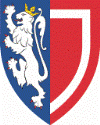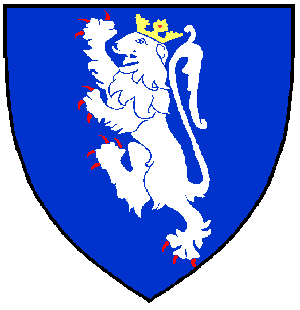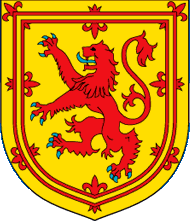Balliol College Archives & Manuscripts |
Back to: HOME > College History > Heraldry
The College Arms
The present arms of the College [Figure 1. Azure, a lion rampant argent, crowned or, impaling Gules, an orle argent] were only adopted and used consistently by it from about 1900. They are taken from the impression on the back of the seal of Dervorguilla of Galloway, Lady of Balliol, which is attached to the Statutes she gave the College in 1282, and which survives intact.
Click on images for larger representations.
The same orle [for Balliol, Figure 2] and lion [for Galloway, Figure 3] were combined in several other fanciful ways during the nineteenth century. Combinations of the Balliol orle and the Royal arms of Scotland [Figure 4. Or, a lion rampant within a double tressure flory and counterflory gules] are also found on nineteenth-century Balliol items. The arms generally employed by the College (e.g. to mark silver, or on bookplates ) before that were simply Gules, an orle argent (Fig. 2): these are the arms on the gate of the Bodleian Library and faded but just visible on the old doors of the College Chapel. None of these arms have ever been authorised except by customary usage; nor have any of them had an associated motto.
Heraldic convention is that the arms of a man and his wife are normally impaled with his on the dexter side (left as viewed) and hers on the sinister side. In Figure 1 the impaling is the other way round proclaiming that her blood was bluer than his. She was a great grand-daughter of King David I of Scotland and it was through her that John Balliol her son claimed the throne of Scotland.
Glossary:
- Argent: the heraldic colour silver or white
- Azure: the heraldic colour blue
- Bordure: a feature which goes all round, and parallel to the boundary
- Counterflory = Counterfleury: having flowers on each side set opposite each other in pairs
- Flory = Fleury: decorated with fleurs-de-lis
- Gules: the heraldic colour red
- Impaling: combined with
- Or: the heraldic colour gold or yellow
- Orle: a band following the outline of the shield, but not extending to the edge of it
- Rampant: rearing or standing with the fore-paws in the air
- Tressure: a diminutive of the orle appearing near the edge of the shield
You do not need to request permission to download or print one copy of any of the images on these pages for your personal private study or research purposes.
You do need to request permission in writing to use any of these images for any publication in any format, including any use on a website.
There is no charge for Archive enquiries, but donations for Archive purposes are always appreciated.
| Updated 11.viii.14
|
Balliol College All rights reserved © 2026 |




